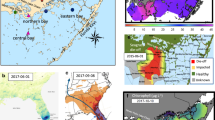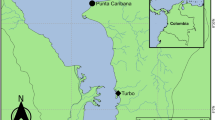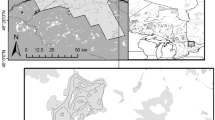Abstract
Cochlodinium polykrikoides formed large blooms in the coastal waters of Oman from October 2008 through mid-January 2009, and satellite images from Aqua-MODIS and region-wide reports suggest that this bloom was found throughout the Arabian Gulf and Sea of Oman for more than 10 months. The unusual occurrence of this species appears to have supplanted the more regularly occurring bloom species, Noctiluca scintillans, in 2008–2009. For the first 2 weeks of the coastal Omani bloom, C. polykrikoides abundance was near monospecific proportions, with cell densities ranging from 4.6 × 103 to 9 × 106 cells L−1 and very high levels of chlorophyll a (78.0 μg L−1) were also recorded. The regional progression of the bloom likely began with stronger than normal upwelling along the Iranian and northern Omani coasts during the southwest monsoon in late summer, followed by discharge of unusually warm coastal plume water along the coast of Oman with the reversal of monsoonal winds in late October. The occurrence and persistence of high densities of C. polykrikoides in Oman coastal water were also significantly influenced by an elevated nutrient load and warmer than normal temperatures. Concentrations of nutrients, especially NH4 +, urea, PO4 3−, and organic nitrogen and phosphorus, were manyfold higher than observed in the year prior or since. These findings suggest that mesoscale features were important in bloom dynamics more regionally, but locally the bloom was sustained by nutrient enrichment supplemented by its mixotrophic capabilities.










Similar content being viewed by others
References
Al Gheihani, H., A. Al-Azri, S. Piontkovoski, S. Debrotsov, I. Al Amri, A. Al Ambo, S. Al Jufaili, S. Al Bousaidi, S. Al Hajri, A. Al Aisari, H. Al Shaqsi, N. Al Abrim and K. Al Hashmi. 2012. Blooms of Cochlodinium polykrikoides along the coast of Oman and their effects. In Proceedings of the 14th international conference on harmful algae, Hersonissos-Crete, Greece, ed. K.A. Pagou, and G. Hallegraeff, pp. 140–142. International Society for the Study of Harmful Algae and Intergovernmental Oceanographic Commission of UNESCO.
Al-Azri, A., K. Al-Hashmi, J. Goes, H. Gomes, A. Rushdi, H. Al-Habsi, S. Al-Khusaibi, R. Al-Kindi, and N. Al-Azri. 2007. Seasonality of the bloom-forming heterotrophic dinoflagellates Noctiluca scintillans in the Gulf of Oman in relation to environmental conditions. International Journal of Oceans and Oceanography 2(1): 51–60.
Al-Azri, A., S.A. Piontkovski, K. Al-Hashmi, J. Goes, and H. Gomes. 2010. Chlorophyll a as a measure of seasonal coupling between phytoplankton and the monsoon periods in the Gulf of Oman. Aquatic Ecology 44: 449–461.
Anton, A., P.L. Teoh, S.R. Mohd-Shaleh, and N. Mohammad-Noor. 2008. First occurrence of Cochlodinium polykrikoides blooms in Sabah, Malaysia. Harmful Algae 7: 331–336.
Banse, K., and S.A. Piontkovski (eds.). 2006. The mesoscale structure of the epipelagic ecosystem of the open northern Arabian Sea. Hyderabad: Universities Press. 248 pp.
Barber, R.T., J. Marra, R.C. Bidigare, L.A. Codispoti, D. Halpern, Z. Johnson, M. Latasa, R. Goericke, and S.L. Smith. 2001. Primary productivity and its regulation in the Arabian Sea during 1995. Deep-Sea Research II 48: 1127–1172.
Barwani, M.A. 1976. Report of Salalah investigation (unpublished report). Ministry of Agriculture and Fisheries Wealth, Oman.
Berktay, A. 2011. Environmental approach and influence of red tide to desalination process in the Middle East. International Journal of Chemical and Environmental Engineering 2: 183–188.
Brink, K., R. Arnone, P. Coble, C. Flagg, B. Jones, J. Kindle, C. Lee, D. Phinney, M. Wood, C. Yentch, and D. Young. 1998. Monsoons boost biological productivity in the Arabian Sea, EOS Transactions. American Geophysical Union 79(13): 168–169.
Brock, J.C., and C.R. McClain. 1992. Interannual variability in phytoplankton blooms observe in the northwestern Arabian Sea during the southwestern monsoon. Journal of Marine Research 97: 733–750.
Bronk, D.A., M.W. Lomas, P.M. Glibert, K.J. Schukert, and M.P. Sanderson. 2000. Total dissolved nitrogen analysis: comparisons between the persulfate, UV and high temperature oxidation methods. Marine Chemistry 69: 163–178.
Burkholder, J.M., P.M. Glibert, and H. Skelton. 2008. Mixotrophy, a major mode of nutrition for harmful algal species in eutrophic waters. Harmful Algae 8: 77–93.
Cho, E.S., G.Y. Kim, B.D. Choi, L.I. Rhodes, T.J. Kim, G.H. Kim, and J.D. Lee. 2001. A comparative study of the harmful dinoflagellates Cochlodinium polykrikoides and Gyrodinium impudicum using transmission electron microscopy, fatty acid composition, carotenoid content, DNA quantification and gene sequences. Botanica Marina 44: 57–66.
Claereboudt, M., G. Hermosa, and E. McLean. 2001. Plausible cause of fish kills in the Gulf of Oman. Proceedings of first international conference on fisheries, aquaculture and environment in the Northern Indian Ocean 2: 123–132.
Curtiss, C.C., G.W. Langlois, L.B. Busse, F. Mazzillo, and M.W. Silver. 2008. The emergence of Cochlodinium along the California Coast (USA). Harmful Algae 7: 337–346.
Dorantes-Aranda, J.J., L.M. Garcia-de la Parra, R.A. Alonso-Rodriguez, and L. Morquecho. 2009. Hemolytic activity and fatty acids composition in the ichthyotoxic dinoflagellates Cochlodinium polykrikoides isolated from Bahia de la Paz, Gulf of California. Marine Pollution Bulletin 58: 1041–1045.
Duce, R.A., J. LaRoche, K. Altieri, K.R. Arrigo, A.R. Baker, D.G. Capone, S. Cornell, F. Dentener, J. Galloway, R.S. Ganeshram, R.J. Geider, T. Jickells, T. Jickells, M.M. Kuypers, R. Langlois, P.S. Liss, S.M. Liu, J.J. Middelburg, C.M. Moore, S. Nickovic, A. Oschlies, T. Pedersen, J. Prospero, R. Schlitzer, S. Seitzinger, L.L. Sorensen, M. Uematsu, O. Ulloa, M. Voss, B. Ward, and L. Zamora. 2008. Impacts of anthropogenic atmospheric nitrogen on the open ocean. Science 320: 893–897.
Ezam, M., A.A. Bidokhti, and A.H. Javid. 2009. Numerical simulations of spreading of the Persian Gulf outflow into the Oman Sea. Ocean Science 6: 3057–3100.
Fatemi, S.M.R., S.M.B. Nabavi, G. Vosoghi, M. Fallahi, and M. Mohammadi. 2012. The relation between environmental parameters of Hormuzgan coastline in Persian Gulf and occurrence of the first harmful algal bloom of Cochlodinium polykrikoides (Gymnodiniaceae). Iranian Journal of Fisheries Sciences 11: 475–489.
Flynn, K.J., D.K. Stoecker, A. Mitra, J.A. Raven, P.M. Glibert, P.J. Hansen, E. Granéli, and J.M. Burkholder. 2013. Misuse of the phytoplankton–zooplankton dichotomy: the need to assign organisms as mixotrophs within plankton functional types. Journal of Plankton Research 35: 3–11.
Gárate-Lizarrága, I., D.J. López-Cortez, J.J. Bustillos-Guzmán, and F. Hernández-Sandoval. 2004. Blooms of Cochlodinium polykrikoides (Gymnodiniaceae) in the Gulf of California, Mexico. Revista de Biología Tropical 52(1): 51–58.
Glibert, P.M. 2007. Eutrophication and harmful algal blooms: a complex global issue, examples from the Arabian Seas including Kuwait Bay, and an introduction to the Global Ecology and Oceanography of Harmful Algal Blooms (GEOHAB) Programme. International Journal of Oceans and Oceanography 2: 157–169.
Glibert, P.M., and J.M. Burkholder. 2011. Eutrophication and HABs: strategies for nutrient uptake and growth outside the Redfield comfort zone. Chinese Journal of Oceanology and Limnology 29: 724–738.
Glibert, P.M., J. Landsberg, J. Evans, M.A. Al-Sarawi, M. Faraj, M.A. Al-Jarallah, A. Haywood, S. Ibrahem, P. Klesius, C. Powell, and C. Shoemaker. 2002. A fish kill of massive proportion in Kuwait Bay, Arabian Gulf, 2001: the roles of infectious bacteria, harmful algae, and eutrophication. Harmful Algae 1: 215–231.
Glibert, P.M., D.M. Anderson, P. Gentien, E. Graneli, and K.G. Sellner. 2005. The global, complex phenomena of harmful algal blooms. Oceanography 18(2): 136–147.
Glibert, P.M., J. Harrison, H. Cynthia, and S. Seitzinger. 2006. Escalating worldwide use of urea—a global change contributing to coastal eutrophication. Biogeochemistry 77: 441–463.
Glibert, P.M., E. Mayorga, and S. Seitzinger. 2008. Prorocentrum minimum tracks anthropogenic nitrogen and phosphorus inputs on a global basis: application of spatially explicit nutrient export models. Harmful Algae 8: 33–38.
Gobler, C.J. 2010. The cause, effects, dynamics and distribution of Cochlodinium polykrikoides blooms and cells in the Peconic Estuary, Suffolk County, NY. 2010. Report to Suffolk County, Department of Health Services. http://peconice.ipower.com/pdf/Gobler%20Cochlodinium%20project%20final%20report%202006%20-%202010.pdf.
Gobler, C.J., D.L. Berry, R.O. Anderson, A. Burson, F. Koch, B.S. Rodgers, L.K. Moore, J.A. Goleski, B. Allam, P. Bowser, Y. Tang, and R. Nuzzi. 2008. Characterization, dynamics, and ecological impacts of harmful Cochlodinium polykrikoides blooms on eastern Long Island, NY, USA. Harmful Algae 7: 293–307.
Goes, J.I., P.G. Thoppil, H.d.R. Gomes and J.T. Fasullo. 2005. Warming of the Eurasian landmass is making the Arabian Sea more productive. Science 308: 545–547.
Gomes, H.J., Goes, P. Matondkar, S. Parab, A. Al-Azri, and P. Thoppil. 2008. Blooms of Noctiluca miliaris in the Arabian Sea—an in situ and satellite study. Deep-Sea Research 55(II): 751–765.
Guzman, H.M., J. Cortes, P.W. Gleynn, and R.H. Richmond. 1990. Coral mortality associated with dinoflagellate blooms in the eastern Pacific (Costa Rica and Panama). Marine Ecology Progress Series 60: 299–303.
Hallegraeff, G.M., and S. Fraga. 1996. Bloom dynamics of the toxic dinoflagellate Gymnodinium catenatum, with emphasis on the Tasmanian and Spanish coastal waters. In Physiological ecology of harmful algal blooms. NATO ASI Series, ed. D.M. Anderson, A.D. Cembella, and G.M. Hallegraeff, 59–80. Berlin: Springer.
Hamzei, S., A.A. Bidokhti, M.S. Mortazavi, and A. Ghebi. 2012. Utilization of satellite imagery for monitoring harmful algal blooms at the Persian Gulf and Gulf of Oman. International Conference on Environmental, Biomedical and Biotechnology. IPCBEE 41: 171–174. IACSIT Press, Singapore. pp. 171–174.
Harrison, P.J., M.H. Hu, Y.P. Yang, and X. Lu. 1990. Phosphate limitation in estuarine and coastal waters of China. Journal of Experimental Marine Biology and Ecology 140: 79–87.
Harrison, P.J., K. Furuya, P.M. Glibert, J. Xu, H.B. Liu, K. Yin, J.H. Lee, D.M. Anderson, R. Gowen, A.R. Al-Azri, and A.Y. Ho. 2011. Geographical distribution of red and green Noctiluca scintillans. Chinese Journal of Oceanology and Limnology 29: 807–831.
Heil, C.A., P.M. Glibert, M.A. Al-Sarawi, M. Faraj, M. Behbehani, and M. Husain. 2001. First record of a fish-killing Gymnodinium sp. bloom in Kuwait Bay, Arabian Gulf: chronology and potential causes. Marine Ecology Progress Series 214: 15–23.
Heil, C.A., P.M. Glibert, and C. Fan. 2005. Prorocentrum minimum (Pavillard) Schiller—a review of a harmful algal bloom species of growing worldwide importance. Harmful Algae 4: 449–470.
Howard, M.D.A., A.C. Jones, A. Schnetzer, P.D. Countway, C.R. Tomas, R.M. Kudela, K. Hayashi, P. Chia, and D.A. Caron. 2012. Quantitative real-time polymerase chain reaction for Cochlodinium fulvescens (Dinophyceae), a harmful dinoflagellate from California coastal waters. Journal of Phycology 48: 384–393.
Jeong, H.J., Y.D. Yoo, T.H. Kim, J.H. Kim, N.S. Kang, and W.H. Yih. 2004. Mixotrophy in the phototrophic harmful alga Cochlodinium polykrikoides (Dinophycean): prey species, the effects of prey concentration and grazing impact. Journal of Eukaryotic Microbiology 51: 563–569.
Kim, C.S., S.G. Lee, H.G. Kim, and J. Jung. 1999. Reactive oxygen species as causative agents in the ichthyotoxicity of the red tide dinoflagellate Cochlodinium polykrikoides. Journal of Plankton Research 21: 2105–2115.
Kim, D.I., Y. Matsuyama, S. Nagasoe, Y.H. Yamaguchi, Y. Oshima, N. Imada, and T. Honjo. 2004. Effects of temperature, salinity and irradiance on the growth of the harmful red tide dinoflagellates Cochlodinium polykrikoides Margalef (Dinophyceae). Journal of Plankton Research 26: 61–66.
Kim, C.J., H.G. Kim, C.H. Kim, and H.M. Oh. 2007. Life cycle of the ichthyotoxic dinoflagellate Cochlodinium polykrikoides in Korean coastal waters. Harmful Algae 6: 104–111.
Knap, A., A. Michaels, A. Close, H. Ducklow, and A. Dickson. 1994. Protocols for the Joint Global Ocean Flux Study (JGOFS) core measurements. JGOFS Report 19: 170.
Kudela, R.M., J.P. Ryan, M.D. Blakeley, J.Q. Lane, and T.D. Peterson. 2008. Linking the physiology and ecology of Cochlodinium to better understand harmful algal bloom events: a comparative approach. Harmful Algae 7: 278–292.
Kudela, R.M., S. Seeyave, and W.P. Cochlan. 2010. The role of nutrients in regulation and promotion of harmful algal blooms in upwelling systems. Progress in Oceanography 85: 122–135.
Larsen, J., and A. Sournia. 1991. Diversity of heterotrophic dinoflagellates. In The biology of free-living heterotrophic dinoflagellates, ed. D.J. Patterson and J. Larsen, 313–332. Oxford: Clarendon.
Lee, D.K. 2008. Cochlodinium polykrikoides blooms and eco-physical conditions in the South Sea of Korea. Harmful Algae 7: 318–323.
Matsuoka, K., Y. Takano, E. Kamrani, H. Rezaei, S. Puthiyedathu, and H. Al Gheilani. 2010. Study on Cochlodinium polykrikoides Margalef in the Oman Sea and the Persian Gulf from August 2008 to August 2009. Current Development in Oceanography 1: 153–171.
Morse, R.E., J. Shen, J.L. Blanco-Garcia, W.S. Hunley, S. Fentress, M. Wiggins, and M.R. Mulholland. 2011. Environmental and physical controls on the formation and transport of blooms of the dinoflagellate Cochlodinium polykrikoides Margalef in the lower Chesapeake Bay and its tributaries. Estuaries and Coasts 34: 1006–1025.
Mulholland, M.R., R.E. Morse, G.E. Boneillo, P.W. Bernhardt, K.C. Filippino, L.A. Procise, J.L. Blanco-Garcia, H.G. Marshall, T.A. Egerton, W.S. Hunley, K.A. Moore, D.L. Berry, and C.J. Gobler. 2009. Understanding causes and impacts of the dinoflagellate, Cochlodinium polykrikoides, blooms in the Chesapeake Bay. Estuaries and Coasts 32: 734–747.
Naqvi, S.W.A., J.W. Moffett, M.U. Gauns, P.V. Narvekar, A.K. Pratihary, H. Naik, D.M. Shenoy, D.A. Jayakumar, T.J. Goepfert, P.K. Patra, A. Al-Azri, and A.I. Ahmed. 2010. The Arabian Sea as a high-nutrient, low-chlorophyll region during the late Southwest Monsoon. Biogeosciences Discussion 7: 25–53.
Pankrantz, T. ed. 2008. Red tide close desalination plants. Water desalination report, vol. 44, Houston, TX.
Parab, S.G., S.G.P. Matondkar, H. Gomes, and J.I. Goes. 2006. Monsoon driven changes in phytoplankton populations in the eastern Arabian Sea as revealed by microscopy and HPLC pigment analysis. Continental Shelf Research 26: 2538–2558.
Pous, S.P., X. Carton, and P. Lazure. 2004. Hydrology and circulation in the Strait of Hormuz and the Gulf of Oman—results from the GOGP99 experiment: 1. Strait of Hormuz. Journal of Geophysical Research 109: C12037.
Qi, D., Y. Huang, and X. Wang. 1993. Toxic dinoflagellate red tide by a Cochlodinium sp. along the coast of Fujian, China. In Toxic phytoplankton blooms in the sea, ed. T.J. Smayda and Y. Shimizu, 235–238. Amsterdam: Elsevier.
Revilla, M., J. Alexander, and P.M. Glibert. 2005. Urea analysis in coastal waters: comparison of enzymatic and direct methods. Limnology Oceanography Methods 3: 290–299.
Richlen, M.L., S.L. Morton, E.A. Jamali, A. Rajan, and D.M. Anderson. 2010. The catastrophic 2008–2009 red tide in the Arabian Gulf region, with observations on the identification and phylogeny of the fish-killing dinoflagellate Cochlodinium polykrikoides. Harmful Algae 9: 163–172.
Round, F.E., R.M. Crawford, and D.G. Mann (eds.). 1990. The diatoms: biology and morphology of the genera, 747. Cambridge: Cambridge University Press.
Saeedi, H., E. Kamrani, and K. Matsuoka. 2011. Catastrophic impact of red tides of Cochlodinium polykrikoides on the razor clam Solen dactylus in coastal waters of the northern Persian Gulf. Journal of the Persian Gulf 2: 13–20.
Schott, F., J.C. Swallow, and M. Fieux. 1990. The Somali current at the equator: annual cycle of currents and transport in the upper 1000m and connection with neighbouring latitudes. Deep-Sea Research II 37: 1825–1848.
Solórzano, L., and J.J. Sharp. 1980. Determination of total dissolved phosphorus and particulate phosphorus in natural waters. Limnology and Oceanography 25: 754–758.
Sournia, A. (ed.). 1986. Atlas du phytoplancton marin. Cyanophycees, Dictyochophycees, Dinophycees et Raphidophycees, vol. I, 215. Paris: Editions CNRS.
Steidinger, K.A., and K. Tangen. 1997. Dinoflagellates. In Identifying marine phytoplankton, ed. C. Tomas, 387–584. New York: Academic.
Subba-Rao, D.V., and F. Al-Yamani. 1998. Phytoplankton ecology in the waters between Shat Al-Arab and Straits of Hormuz, Arabian Gulf: a review. Plankton Biology and Ecology 45(2): 101–116.
Thangaraja, M. 1990. Studies on red tides off Oman. MSFC Research Report Number 90–2. Ministry of Agriculture and Fisheries, Oman.
Thangaraja, M., A. Al-Aisry, and L. Al-Kharusi. 2007. Harmful algal blooms and their impacts in the middle and outer ROPME Sea area. International Journal of Ocean and Oceanography 2: 85–98.
Throndsen, J. 1978. Preservation and storage. In Monographs on oceanographic methodology 6: phytoplankton manual, ed. A. Sournia. Paris: United Nations Educational, Scientific and Cultural Organisation (UNESCO).
Tomas, C.R. (ed.). 1997. Identifying marine phytoplankton, 686. San Diego: Academic.
Tomas, C.R., and T.J. Smayda. 2008. Red tide blooms of Cochlodinium polykrikoides in a coastal cove. Harmful Algae 7: 308–317.
Wiggert, J.D., B.H. Jones, T.D. Dickey, K.H. Brink, R.A. Weller, J. Marra, and L.A. Codispoti. 2010. The Northeast Monsoon's impact on mixing and phytoplankton biomass and nutrient cycling in the Arabian Sea. Deep-Sea Research II 47: 1353–1385.
Yang, J.S., H.Y. Choi, J.Y. Jeong, and J.K. Park. 2000. The outbreak of red tides in the coastal waters off Goheung, Chonnam, Korea: 1. Physical and chemical characteristics in 1997. Journal of Oceanological Society of Korea 5: 16–26.
Yuki, K., and S. Yoshimatsu. 1989. Two fish-killing of Cochlodinium from Harina-Nada, Seto Inland Sea Japan. In Red tides: biology, environmental science, and toxicology, ed. T. Okaichi, D.M. Anderson, and T. Nemoto, 451–454. New York: Elsevier.
Acknowledgments
This study was funded by the Sultan Qaboos University internal grants (IG/AGR/FISH/07/01, IG/AGR/FISH/09/01, and IG/AGR/FISH/13/01). We thank Harub Al Habsi, Salem Al khusaibi for sampling and analysis and crew of R/V Al Jamia. Issa Al Amri College of Medicine for assistance with Electronic microscopy. Funding for PMG was provided by NSF grant number OCE-1015980. We thank J. Alexander for analytical assistance with Electronic microscopy. Funding for JIG and HRG was provided by NASA Grant NNX11AE22G and NSF Grants OCE-1121022 and OCE-1121039. This is contribution number 4785 from the University of Maryland Center for Environmental Science.
Author information
Authors and Affiliations
Corresponding author
Additional information
Communicated by Wayne S. Gardner
Rights and permissions
About this article
Cite this article
Al-Azri, A.R., Piontkovski, S.A., Al-Hashmi, K.A. et al. Mesoscale and Nutrient Conditions Associated with the Massive 2008 Cochlodinium polykrikoides Bloom in the Sea of Oman/Arabian Gulf. Estuaries and Coasts 37, 325–338 (2014). https://doi.org/10.1007/s12237-013-9693-1
Received:
Revised:
Accepted:
Published:
Issue Date:
DOI: https://doi.org/10.1007/s12237-013-9693-1




